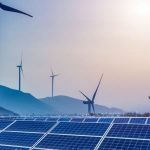This isn’t a revolution. It’s an evolution, and while that may lack the shock and awe of something like the shale boom, its long-term impact is extreme. This is the world of renewable energy, and three decades of progress shows a clear and undeniable pattern. close [x]PauseUnmuteLoaded: 0%Progress: 0%Remaining Time -0:05Fullscreen
It’s hard to believe that we’ve been using solar and wind power for about thirty years now. The technology behind this type of renewable power generation may be even older, but the first data for solar and wind generation dates back only to 1990.
Even more fascinating is the fact that Europe was not among the first adopters of solar and wind. The greenest continent today only ventured into the two in 1997.
The energy world has changed in the past twenty years.
Some renewable energy sources have been around forever. Take Iceland, for example, and its geysers. Iceland is the top global performer in renewable energy thanks to its geothermal resources. Or, there is Costa Rica: the tiny nation boasted 100-percent renewable energy generation for more than two straight months twice over two years.
There is also the UK, which was rightfully proud of having more of its electricity generated from renewable sources than fossil fuels during 2019. It’s perhaps worth noting that the biggest share of this zero-carbon electricity came from nuclear power—26.5 percent of the energy mix—and some renewable energy purists shun nuclear as an alternative to fossil fuels. Yet it is an emissions-free source of electricity nevertheless and deserves its place among zero-carbon generation sources.
The list of examples demonstrating the world’s evolution in energy sourcing and use could continue. The important outtake of all these examples, however, is that when something makes economic sense, it will be used. This brings us to the topic of renewable energy costs and the role of these costs in the growing adoption of renewable power generation systems.
Once upon a time in the 1990s, both solar and wind power was expensive, not to mention lacking in efficiency. In 1992, the highest efficiency rate for solar panels was 16 percent. This grew to 17.8 by 2012 and to almost 30 percent in 2016. Today, there are photovoltaic materials that can reach efficiency rates of over 40 percent. Meanwhile, costs fell from an average cost of solar panel installation in the U.S. was $8.50 per watt in 2009. Today, it is about $2.96 per watt.Related: Billions In Worthless Assets Plague The Oil & Gas Industry
In wind, the efficiency improvements over the last 20 years have been a lot more spectacular because the technology allows for spectacular improvements. In the United States, the average generating capacity of new turbines in 2018 was 239 percent higher than in 1998, at 2.4 MW. This was the result of taller hubs and longer turbine blades. At the same time, installation costs have been falling. In 2018 a kW of installed capacity cost $1,470 in the U.S., down as much as 40 percent from 2009.
This combination of falling costs, rising efficiency ratios and government support have been the key drivers of wind and solar.
There have been reports about solar and wind becoming cost-competitive with coal in some parts of the world, yet government subsidies are still a big factor in investment decisions.
A case in point is China, where Beijing’s moved to cut subsidies for new solar and wind capacity after it realized the subsidy tab had grown to a staggering $15.6 billion by 2017. Beijing is still paying that off, and is now requiring that wind and solar developers first prove that their projects are cost-competitive with coal-powered generation.
Besides subsidies, pro-renewables legislation has also had a part to play in the energy transformation of the world over the last 20 years, especially over the last decade. The proliferation of social networks has made everyone more aware of topics such as climate change and emissions, and has spurred a lot of real-life protests against these. These protests, in turn, have pushed politicians to approve clean energy initiatives and set ambitious timetables for going 100-percent green.
Everyone seems to have 100-percent green energy plans these days, including some of the world’s worst emissions offenders such as China and India. Europe is in the lead as regards clean energy ambitions, and while the U.S. has yet to catch up in terms of such ambitions, the share of renewable energy in the world’s largest oil producer is rising steadily.Related: The Middle East Oil Conflict That Could Be Bigger Than The Iran Crisis
Unfortunately, reality begs to differ from the ambitions of politicians and the sincere desires for a cleaner future of millions of people. The world had total renewable energy capacity of 2.356 million MW at the end of 2018, up from 1.135 million MW in 2009, according to data from IRENA.
Still, emissions are rising.
These hit a record high in 2018 despite the growing adoption of renewable energy and are now expected to have broken this record in 2019. The culprits: China and India along with other developing nations with heavy industries that require cheap and reliable power, which most renewable installations cannot guarantee for lack of storage capacity.
The good news, according to the Global Carbon Project that tracks emissions, is that despite the record-high level of emissions, the increase is slowing down. Fossil fuel-related emissions rose 2 percent in 2018 but are expected to have added just another 0.6 percent in 2019.
The renewables revolution will likely never happen. What is happening, however, is a renewables evolution. That’s arguably a much more reliable way to change the ways in which the world sources its energy and the ways it uses it. Revolutions, as opposed to evolution, tend to eat their children, after all.







